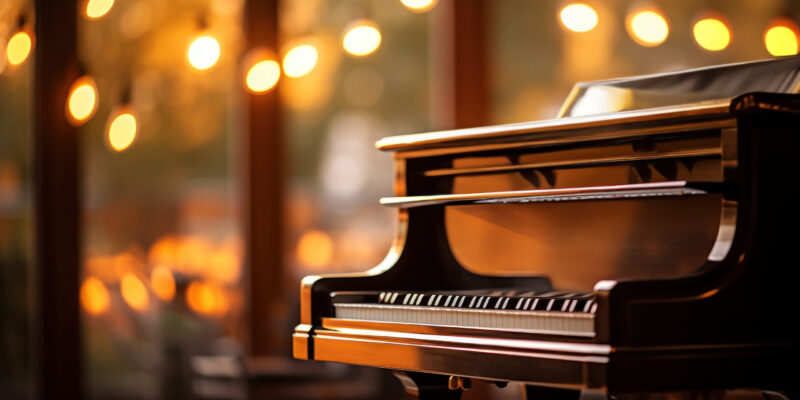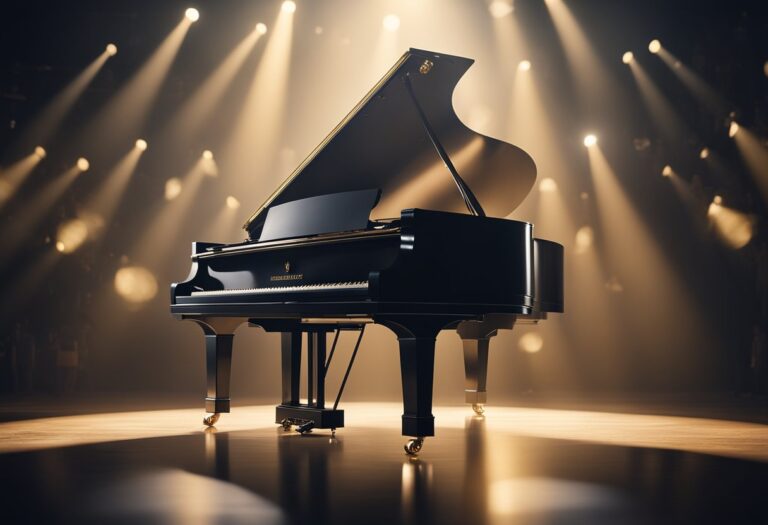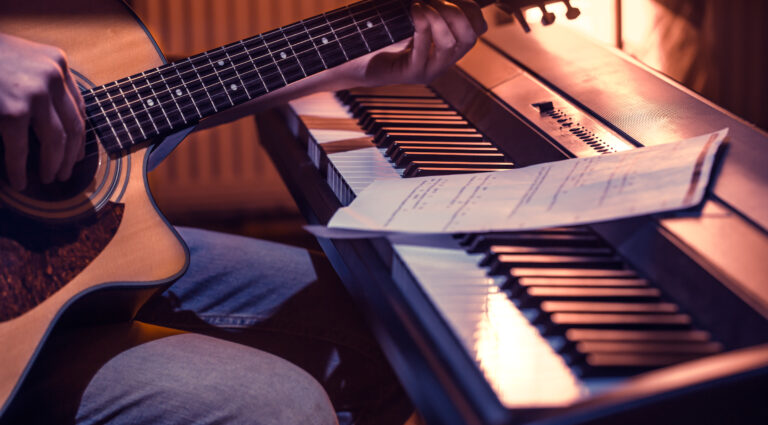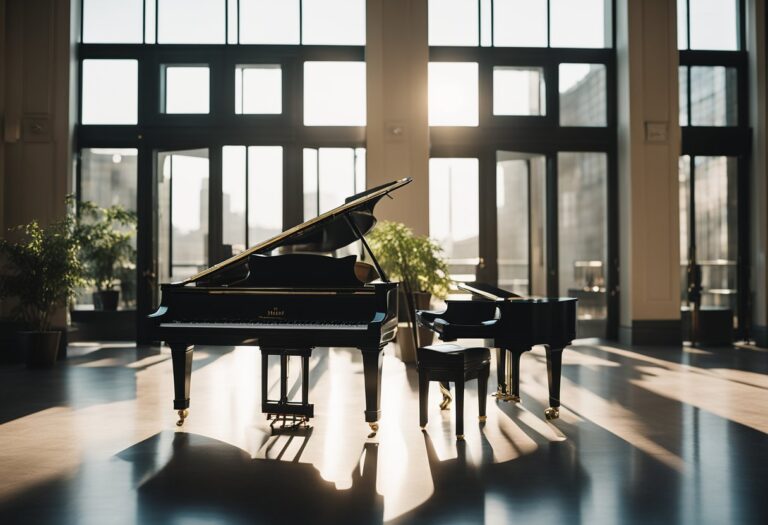The Enigmatic Creation: Unraveling the Mystery of Piano Making
The piano is a beautiful instrument that has been around for centuries. It is a complex and intricate instrument, and many people wonder how it is made. In this article, you will learn about the process of making a piano, from the materials used to the final product.

The first step in making a piano is to select the wood. The wood used for the soundboard, the back, and the sides of the piano must be carefully chosen to ensure the best sound quality. Spruce is the most commonly used wood for the soundboard, while maple is used for the back and sides. Once the wood is selected, it is cut into the appropriate sizes and shapes.
Next, the frame of the piano is constructed. The frame is made of cast iron, which is strong enough to support the tension of the strings. The frame is then attached to the wooden structure of the piano. The strings are then attached to the frame, and the hammers are added. The hammers are made of felt and are responsible for striking the strings to produce sound. The keys are then added, and the piano is ready to be tuned.
History of the Piano

Evolution from Early Keyboard Instruments
The piano is a musical instrument that has been around for centuries. It has evolved from early keyboard instruments such as the clavichord and harpsichord. The clavichord was the earliest keyboard instrument that was capable of playing dynamic levels of sound. It was made of wood and had strings that were struck by metal tangents. However, it was not very loud and could not sustain notes for very long.
The harpsichord was another early keyboard instrument that was popular during the Renaissance and Baroque periods. It had a similar design to the clavichord, but instead of striking the strings, it plucked them with a quill. The harpsichord was louder than the clavichord but still lacked the ability to play with dynamic levels of sound.
Innovations and Inventors
In the 18th century, a new instrument called the pianoforte was invented. It had a hammer mechanism that allowed the player to control the volume and sustain of each note. The first pianoforte was invented by Bartolomeo Cristofori in Italy in the early 1700s. He called his invention a gravicembalo col piano e forte, which means “harpsichord with soft and loud” in Italian.
The pianoforte was further developed and improved upon by other inventors such as Johann Andreas Stein, who added a damper pedal to the instrument. This allowed the player to sustain notes even after releasing the keys. In the 19th century, the piano was further improved with the addition of a cast iron frame, which allowed for greater tension on the strings and a louder sound.
Today, the piano is a popular instrument that is used in a wide range of musical genres. It is still made with a similar design to the early pianofortes but with modern materials and technology. The history of the piano is a fascinating one, and it continues to evolve and inspire musicians around the world.
Materials and Components

Types of Wood
The piano is made up of many different types of wood, each with its own unique properties and uses. The soundboard is typically made from spruce, which is known for its strength and resonance. The frame is usually made from hardwoods such as maple or beech, which are strong and durable. The keys are made from a combination of hardwoods and softwoods, such as ebony and basswood, which provide a balance of strength and flexibility.
Strings and Soundboard
The strings of a piano are made from steel wire, which is wound tightly around a core of copper or other metals. The soundboard is responsible for amplifying the sound of the strings and is made from spruce or other woods that are able to vibrate at high frequencies. The bridge, which connects the strings to the soundboard, is typically made from hardwoods such as maple or beech.
Keys and Action Mechanism
The keys of a piano are made from a combination of hardwoods and softwoods, with the black keys typically made from ebony and the white keys made from a combination of hardwoods such as maple and softwoods such as basswood. The action mechanism is responsible for transferring the motion of the keys to the hammers, which strike the strings. It is made up of many different components, including hammer shanks, flanges, and repetition levers, all of which are made from various types of wood and metal.
The piano is a complex instrument made up of many different materials and components, each with its own unique properties and uses. From the soundboard to the keys to the action mechanism, every part of the piano plays an important role in producing the beautiful sound that we all know and love.
Manufacturing Process
Woodworking and Assembly
The manufacturing process of a piano begins with the selection of high-quality woods, typically spruce, maple, and mahogany. The wood is then cut into various parts, such as the soundboard, ribs, and bridges. These parts are then assembled to create the basic structure of the piano.
The rim, or outer frame of the piano, is usually made of several layers of hardwood laminated together. The rim is then bent into shape and fitted with the soundboard, which is the heart of the piano. The soundboard is a large, thin piece of spruce that amplifies the sound of the strings.
Stringing and Tuning
Once the basic structure of the piano is complete, the strings are added. The strings are made of high-quality steel wire, and each one is carefully measured and cut to the correct length. The strings are then attached to the soundboard and the tuning pins.
The piano is then tuned, which involves adjusting the tension of each string to produce the correct pitch. This process requires great skill and precision and is usually done by a professional piano tuner.
Finishing and Detailing
The final stage of the manufacturing process involves finishing and detailing the piano. The exterior of the piano is typically finished with a high-gloss lacquer, which gives it a beautiful and durable finish. The keys are made of ivory or plastic and are carefully shaped and polished to ensure a smooth and comfortable playing surface.
Other finishing details include adding the pedals, which control the sustain and softness of the sound, and adding the decorative trim and hardware. Once all of these details are complete, the piano is ready to be shipped to its new owner.
The manufacturing process of a piano is a complex and intricate process that requires great skill and attention to detail. The result is a beautiful and timeless instrument that can bring joy and inspiration to musicians and music lovers for generations to come.
Types of Pianos

Pianos come in different shapes and sizes, and each type has its own unique sound and characteristics. Here are the three main types of pianos:
Grand Pianos
Grand pianos are the largest and most luxurious type of piano. They have a grand, rich sound, and are often used in concert halls and recording studios. Grand pianos have a long, horizontal frame and a lid that can be opened to project the sound. They come in different sizes, ranging from the petite baby grand to the massive concert grand.
Upright Pianos
Upright pianos, also known as vertical pianos, are a more compact and affordable option. They have a vertical frame and strings, and their sound is more muted compared to grand pianos. Upright pianos are suitable for smaller spaces and are often used in homes and music schools. They come in different sizes and styles, such as the spinet, console, and studio upright.
Digital Pianos
Digital pianos are a modern alternative to acoustic pianos. They use electronic technology to produce sound and can mimic the sound and feel of an acoustic piano. Digital pianos are more affordable and portable than acoustic pianos, and they come with various features such as headphone jacks, recording capabilities, and different instrument sounds. They are popular among beginners, music producers, and those who want a space-saving option.
In summary, the type of piano you choose depends on your budget, space, and musical preferences. Whether you opt for a grand, upright, or digital piano, each type has its own unique advantages and can provide you with years of musical enjoyment.
Quality and Craftsmanship

When it comes to piano manufacturing, quality and craftsmanship are of utmost importance. In this section, we will discuss the differences between handcrafting and mass production, as well as the inspection and testing process that ensures the highest quality of each piano.
Handcrafting vs. Mass Production
Handcrafting a piano involves a team of skilled artisans who meticulously work on each component of the instrument, from the soundboard to the keys. This process can take several months to complete, but it ensures that each piano has a unique character and exceptional sound quality.
On the other hand, mass production involves the use of machines and assembly lines to produce pianos in large quantities. While this process is faster and more cost-effective, it can result in a lack of individuality and a lower quality of sound.
Inspection and Testing
Regardless of the manufacturing process, each piano undergoes a rigorous inspection and testing process to ensure its quality. This process includes checking the tuning, voicing, and regulation of the instrument to ensure that it meets the manufacturer’s standards.
In addition, each component of the piano is inspected for any defects or imperfections that could affect the sound quality or durability of the instrument. This attention to detail ensures that each piano that leaves the factory is of the highest quality and will provide years of enjoyment for its owner.
In conclusion, quality and craftsmanship are essential elements of piano manufacturing. Whether a piano is handcrafted or mass-produced, the inspection and testing process ensures that each instrument meets the highest standards of quality and sound.
Frequently Asked Questions
What materials are used in the construction of a piano?
Pianos are typically constructed using a variety of materials, including wood, metal, and felt. The frame and soundboard are typically made of high-quality hardwoods, such as spruce or maple. The strings are made of high-tensile steel wire, and the hammers are made of felt. The keys are usually made of wood, and the pedals are made of metal.
What are the steps involved in manufacturing a piano?
The manufacturing process for a piano is complex and involves many steps. First, the frame and soundboard are constructed, followed by the installation of the strings and hammers. The keys are then crafted and assembled, and the pedals are installed. Finally, the piano is tuned and tested to ensure that it meets the manufacturer’s standards for sound quality and performance.
How are piano keys crafted and assembled?
Piano keys are typically made from high-quality hardwoods, such as maple or mahogany. The keys are then cut to the proper size and shape, and the white keys are covered with a layer of ivory or plastic. Next, the keys are fitted with the necessary hardware, including the keybed, keyframe, and key bushings. Finally, the keys are assembled and installed in the piano.
What is the process for stringing a piano?
Stringing a piano involves installing high-tensile steel wire strings of varying lengths and thicknesses to produce the desired sound. The strings are attached to the soundboard and frame using specialized hardware, and they are carefully tuned to produce the correct pitch and tone. Stringing a piano is a delicate and precise process that requires skill and expertise.
How do manufacturers ensure the quality of a piano during production?
Manufacturers use a variety of quality control measures to ensure that each piano meets their high standards for sound quality and performance. This includes using high-quality materials, employing skilled craftsmen, and conducting rigorous testing and tuning during the manufacturing process. Manufacturers also conduct extensive testing and inspection of each piano before it leaves the factory to ensure that it meets their strict quality standards.
What are the different types of pianos and how are they made differently?
There are several different types of pianos, including grand pianos, upright pianos, and digital pianos. Grand pianos are typically larger and more expensive than upright pianos, and they produce a richer, more complex sound. Upright pianos are more compact and affordable, and they are often used in homes and small performance venues. Digital pianos use electronic technology to simulate the sound and feel of a traditional piano, and they are often used in recording studios and live performances where space is limited. Each type of piano is made differently to produce its unique sound and performance characteristics.






